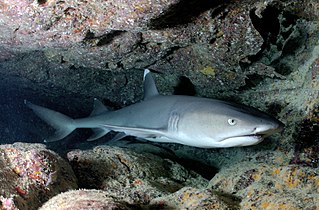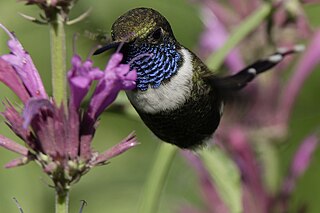
The whitetip reef shark is a species of requiem shark, in the family Carcharhinidae, and the only member of its genus. A small shark that does not usually exceed 1.6 m (5.2 ft) in length, this species is easily recognizable by its slender body and short but broad head, as well as tubular skin flaps beside the nostrils, oval eyes with vertical pupils, and white-tipped dorsal and caudal fins. One of the most common sharks found on Indo-Pacific coral reefs, the whitetip reef shark occurs as far west as South Africa and as far east as Central America. It is typically found on or near the bottom in clear water, at a depth of 8–40 m (26–131 ft).

Niels Kaare Krabbe is a Danish ornithologist and bird conservationist for many years based at the Vertebrate Department of the Zoological Museum, University of Copenhagen and tutored by Jon Fjeldså. His research interests include various aspects of ornithology, especially bioacoustics, conservation, and systematics and altitudinal replacements of Scytalopus tapaculos. He has worked extensively in the Andes, especially Ecuador, and wrote the passerine section of Birds of the High Andes (1990) and the accounts of most Andean species in Threatened Birds of the Americas (1992). He has helped build up a large tissue collection in the Zoological Museum and has authored or coauthored several bioacoustic publications and peer-reviewed papers in scientific journals.

The rufous-tailed hummingbird is a medium-sized hummingbird in the "emeralds", tribe Trochilini of subfamily Trochilinae. It is found from east-central Mexico through Central America and Colombia into Ecuador and Venezuela.

The bronze-tailed plumeleteer is a species of hummingbird in the "emeralds", tribe Trochilini of subfamily Trochilinae. It is found in Colombia, Costa Rica, Ecuador, Nicaragua, and Panama.

The collared inca is a species of hummingbird found in humid Andean forests from western Venezuela through Colombia and Ecuador to Peru. It is very distinctive in having a white chest-patch and white on the tail. Like other hummingbirds it takes energy from flower nectar, while the plant benefits from the symbiotic relationship by being pollinated. Its protein source is small arthropods such as insects. It is normally solitary and can be found at varying heights above the ground, often in the open.

The purple-bibbed whitetip is a species of hummingbird in the "brilliants", tribe Heliantheini in subfamily Lesbiinae. It is found in Colombia and Ecuador.

The white-booted racket-tail is a species of hummingbird in the "brilliants", tribe Heliantheini in subfamily Lesbiinae. It is found in Colombia, Ecuador, and Venezuela.

The buff-tailed sicklebill is a species of hermit hummingbird from the lower Andes and adjacent west Amazonian lowlands from southern Colombia and northern Ecuador to Peru and Bolivia.

Flight feathers are the long, stiff, asymmetrically shaped, but symmetrically paired pennaceous feathers on the wings or tail of a bird; those on the wings are called remiges, singular remex, while those on the tail are called rectrices, singular rectrix. The primary function of the flight feathers is to aid in the generation of both thrust and lift, thereby enabling flight. The flight feathers of some birds perform additional functions, generally associated with territorial displays, courtship rituals or feeding methods. In some species, these feathers have developed into long showy plumes used in visual courtship displays, while in others they create a sound during display flights. Tiny serrations on the leading edge of their remiges help owls to fly silently, while the extra-stiff rectrices of woodpeckers help them to brace against tree trunks as they hammer on them. Even flightless birds still retain flight feathers, though sometimes in radically modified forms.

The bumblebee hummingbird is a species of hummingbird in tribe Mellisugini of subfamily Trochilinae, the "bee hummingbirds". It is endemic to Mexico, but has occurred as a vagrant in the United States.

Boissonneaua is a small genus of hummingbirds in the family Trochilidae. They are found in humid Andean forests from western Venezuela to southern Peru. They have a straight black bill, contrasting outer rectrices, and a distinctive habit of quickly lifting both wings up shortly after landing, thereby revealing their rufous underwing coverts.

The white-vented plumeleteer is a species of hummingbird in the "emeralds", tribe Trochilini of subfamily Trochilinae. It is found in Colombia, Ecuador, Panama, Peru, and Venezuela.

The violet-bellied hummingbird is a species of hummingbird characterized by the male's shimmering violet belly.

The racket-tipped thorntail, formerly called racket-tailed coquette, is a species of hummingbird in subfamily lesbiinae of family Trochilidae. It is found in Brazil, Colombia, French Guiana, Guyana, Suriname, and Venezuela.

The black jacobin is a species of hummingbird in the family Trochilidae. It is found in Argentina, Brazil, Paraguay, and Uruguay.

The scaly-breasted hummingbird or scaly-breasted sabrewing is a species of hummingbird in the "emeralds", tribe Trochilini of subfamily Trochilinae. It is found in Belize, Colombia, Costa Rica, Guatemala, Honduras, Mexico, Nicaragua, and Panama.

The sparkling-tailed woodstar, also known as the sparkling-tailed hummingbird, is a species of hummingbird in tribe Mellisugini of subfamily Trochilinae, the "bee hummingbirds". It is the only species placed in the genus Tilmatura. It is found in El Salvador, Guatemala, Honduras, Mexico, and Nicaragua.

The topazes are two species of hummingbirds in the genus Topaza. They are found in humid forests in the Amazon Basin. Males are by far the largest hummingbirds in their range – the giant hummingbird of the Andes is the only larger species in the family. Males have a total length of about 22 cm, although this includes their elongated rectrices. They are colourful, being mainly strongly iridescent golden and crimson with a black hood and a green throat. Females lack the elongated rectrices and have a mainly green plumage.

The rufous-vented whitetip is a species of hummingbird in the "brilliants", tribe Heliantheini in subfamily Lesbiinae. It is found in Colombia, Ecuador and Peru.

The green-headed hillstar is a species of hummingbird found in the Andes of southern Ecuador and northern and central Peru. It is one of 6 species in the genus Oreotrochilus, and can be distinguished from its relatives by subtle differences in plumage coloration. The green-headed hillstar received its name due to its bronze and green crown and gorget of bright emerald green plumage. The species was first discovered by English ornithologist Osbert Salvin in 1895 and named after Polish ornithologist Jean Stanislaus Stolzmann.
























